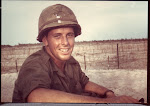DA
NANG, VIET NAM: It’s been 40 years since
that Easter Sunday in 1975 when two Russian deuce and a half trucks filled with
troops, men, and women of the Vietnamese National Liberation Front (VC), rolled
into Da Nang city from the countryside of Central Viet Nam.
This
second largest city of that war-torn country had been abandoned by its
leaders. Soldiers from the Army of South
Vietnam (ARVN) had shed their uniforms and melted into the remaining
population. Many from that population
had fled by sea or air in the preceding days.
The few Americans who remained in Da Nang until the end were personnel
from the U.S. Consulate located on the Han River. They had flown out on helicopters the
preceding day. The U.S. Marines who
administered Military Region I (I Corps), the area from Chu Lai to the DMZ for
the duration of the war, had long gone.
The world’s largest military was heading towards its most ignominious
military defeat.
Ho
Thi Nhi, a former employee of the World Bank here in Da Nang, was ten years old
at the time. “My father was employed by
the ARVN,” he recounted, “and we lived in a military area where most of the
high ranking officers and their families lived.
They had all left for Saigon with their families. There was no one left to lead the ARVN. The streets were full of abandoned military
uniforms and weapons. I was so scared.”
Shortly
after the arrival of the trucks came the tanks of the conquering army of North
Viet Nam, the NVA. Following them came
columns of infantry, the ‘bo doi’, the foot soldiers from the North who had
survived the grueling ten year war.
Eventually locals, refugees, and former ARVN alike lined the streets
smiling and waving the flag of the National Liberation Front. Da Nang had fallen into the hands of the NVA
without a shot being fired.
Until
20 years ago, Da Nang had not changed a great deal from the days of the
American War here. Remnants of that
conflict were evidenced all over the airport grounds and the large U.S. Marine
base in the vicinity of China Beach and Marble Mountain.
Le
Thi Tam operates a small pub, motorbike rental, military tours, and a surf
board rental service a few blocks in from the old China Beach, one of the U.S.
Military’s many R&R (rest and recuperation) centers during the war. The surf boards were a gift from a customer a
few years back, Jimmy Buffet. There is a
picture of the film director Oliver Stone, the local expats, and Tam on the
wall from 1998.
 |
| Mark Conroy (left) and Le Thi Tam (right) at Tam's Pub, near the old Marine base on China Beach. |
Tam
and her family eventually returned, and survived. It has been a struggle for her though, over
these past forty years. Perhaps in part
because of her affiliation with the U.S. Marines so many years ago.
American
veterans today would never recognize the China Beach playground from their time
in Viet Nam. Much of it today looks more like
Miami Beach. The ten kilometer stretch
from Monkey Mountain down past Marble Mountain is lined with high-end
resorts. There is one luxurious
Casino. At this point, most of the
customers are from Hanoi, which has nothing like the beaches here, and other
Asian nations led by Korea and Japan.
 |
| Present day My Khe Beach on the Da Nang shoreline, the location of the U.S. Marines China Beach R&R center on the then China Beach. |
Monkey Mountain, the Son Tra peninsula, is the site of the "InterContinental Da Nang Sun Peninsula Resort," the most luxurious 5 star resort in this part of SE Asia. Long gone are the days when U.S. Marines patrolled the steep, forested banks and cliffs of Monkey Mountain, where a headquarters of the National Liberation Front, the VC, remained throughout the war. The world's rich and powerful now relax on the shores where sampans once delivered supplies to the native troops.
The
ramp at Da Nang International Airport was recently lined with corporate jets when
many of the world’s elite arrived for a conference at the InterContinental, and
replaced the U.S. Marines and the Viet Cong in the jungles of the Son Tra, on
the shores of the South China Sea where so many from both sides had met their
death.
 |
| Fishing boats of the shore of Monkey Mountain, Son Tra peninsula. |
 |
| Along present day My Khe Beach. |




No comments:
Post a Comment